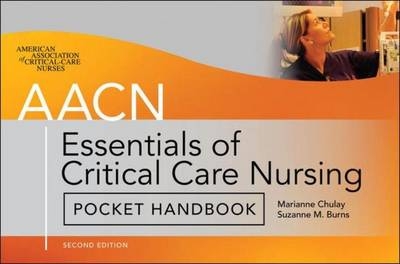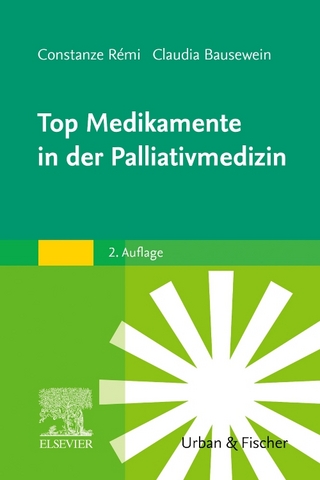
AACN Essentials of Critical Care Nursing Pocket Handbook, Second Edition
McGraw-Hill Medical (Verlag)
978-0-07-166408-0 (ISBN)
- Titel ist leider vergriffen;
keine Neuauflage - Artikel merken
Essential Data Critical Care Nurses Must Know
Endorsed by the American Association of Critical-Care Nurses, this go-anywhere handbook features tables and figures that encapsulate all the information required to give safe and effective care to critically ill patients.
Contents include: Critical Care Drug Tables • Normal Values for Laboratory Tests and Physiologic Parameters • Lists of Assessment Components • Cardiac Rhythms: ECG Characteristics and Treatment Guides, Including Sample Rhythm Strips • 12-Lead ECG Changes in Acute Myocardial Ischemia and Infarct • Troubleshooting Guide for Hemodynamic Monitoring Equipment • Indications for Mechanical Ventilation • Weaning Assessment Tool • ACLS Algorithms.
Mariannce Chulay, RN, PhD, FAAN, Consultant, Clinical Research and Critical Care Nursing, Chapel Hill, NC Suzanne M. Burns, RN, MSN, RRT, ACNP, CCRN, FAAN, FCCM is a Professor of Nursing, Acute and Specialty Care at the University of Virginia, Charlottesville, VA, USA The American Association of Critical-Care Nurses is the world's largest specialty nursing organization, representing more than 400,000 acute and critical care nurses and serving more than 100,000 members, certificants and nurse constituents. Web site: www.aacn.org
Section I. Normal Values
1.1 Normal Values Table
Section II. Assessment
2.1 Summary of Prearrival and Admission Quick Check Assessments
2.2 Summary of Comprehensive Admission Assessment
2.3 Suggested Questions for Review of Past History Categorized by Body System
2.4 Ongoing Assessment Template
2.5 Identification of Symptom Characteristics
2.6 Chest Pain Assessment
2.7 Pain Assessment Tools Commonly Used in Critically Ill Patients
2.8 CAM-ICU Worksheet
2.9 Glasgow Coma Scale
2.10 Sensory Dermatomes
2.11 Edema Rating Scale
2.12 Peripheral Pulse Rating Scale
2.13 Physiologic Effects of Aging
Section III. ECG Concepts
3.1 ECG Lead Placement for a Three-Wire System
3.2 ECG Lead Placement for a Five-Wire System
3.3 Twelve-Lead ECG Placement
3.4 Right Side ECG chest Lead Placement
3.5 Waves, Complexes, and Intervals
3.6 Heart Rate Determination
3.7 Heart Rate Determination Using the Electrocardiogram Large Boxes
3.8 Recommended Leads for Continuous ECG Monitoring
3.9 Advantages of Common Monitoring Leads
3.10 Evidence-Based Practice: Bedside Cardiac Monitoring for Arrhythmia Detection
3.11 Evidence-Based Practice: ST-Segment Monitoring
3.12 Cardiac Rhythms, ECG Characteristics, and Treatment Guide
3.13 Guidelines for Management of Atrial Fibrillation and Atrial Flutter (Class I Recommendations Only)
3.14 Guidelines for Management of Supraventricular Arrhythmias (Class I Recommendations Only)
3.15 Guidelines for Management of Ventricular Arrhythmias (Class I Recommendations Only)
3.16 Normal 12-Lead ECG Waves
3.17 Normal ST Segment and T Waves
3.18 Zones of Myocardial Ischemia, Injury, and Infarction with Associated ECG Changes
3.19 ECG Patterns Associated with Myocardial Ischemia
3.20 ECG Patterns Associated with Acute Myocardial Injury
3.21 ECG Changes Associated with Myocardial Infarction
3.22 Typical Plasma Profiles
3.23 Clinical Presentation of Myocardial Ischemia and Infarction
3.24 Evidence-Based Practice: acute Coronary Syndrome ST-Elevation MI and Non-ST-Elevation MI
3.25 Summary of Causes of Axis Deviations
3.26 ECG Clues for Differentiating Aberation from Ventricular Ectopy
3.27 Pacemaker Codes
3.28 Dual-Chamber Pacing Modes
Section IV. Cardiovascular Concepts
4.1 Intra-Aortic Ballon Pump Frequency of 1:2
4.2 Intra-Aortic Ballon Pump Frequency of 1:1
4.3 Inaccurate Intra-Aortic Ballon Pump Timing
4.4 Advanced Cardiovascular Life Support (ACLS) Pulseless Arrest Algorithm
4.5 Advanced Cardiovascular Life Support (ACLS) Bradycardia Algorithm
4.6 Advanced Cardiovascular Life Support (ACLS) Tachycardia Algorithm
4.7 Problems Encountered with Arterial Catheters
4.8 Inaccurate Arterial Pressure Measurements
4.9 Pulmonary Artery Port Functions
4.10 Leveling of the PA Catheter
4.11 Referencing and Zeroing the Hemodynamic Monitoring System
4.12 Assessing Damping Concepts from Square Wave Test
4.13 Pressure Waveforms Observed during Pulmonary Artery Catheter Insertion
4.14 Pulmonary Artery Waveform and Components
4.15 Effect of a Mechanical Ventilator Breath on PA Waveform
4.16 Reading End Expiration Before a Spontaneous Breath
4.17 Evidence-Based Practice: Pulmonary Artery Pressure Measurement
4.18 Problems Encountered with Pulmonary Artery Catheters
4.19 Inaccurate Pulmonary Artery Pressure Measurements
4.20 Troubleshooting Problems with Thermodilution Cardiac Output Measurements
4.21 Common Inotropic Therapies in Treating Abnormal Hemodynamics
4.22 Common Preload Reducers for Abnormal Hemodynamics
4.23 Common Afterload Reducing Agents
Section V. Respiratory Concepts
5.1 Normal Chest X-Ray
5.2 Mediastinal Structures Visible on a Chest X-Ray
5.3 Chest X-Ray of COPD
5.4 Chest X-Ray of Pneumothorax
5.5 Chest X-Ray of Right Lower Lobe Pneumonia
5.6 Chest X-Ray Showing Carina and Right Bronchus
5.7 Chest X-Ray with PA Catheter, ET Tube, and Chest Tube
5.8 Acid-Base Abnormalities
5.9 Indications for Mechanical Ventilation
5.10 Pulmonary Specific Wean Criteria Thresholds (Pulmonary Specific)
5.11 Burns' Wean Assessment Program (BWAP)
5.12 Algorithm for Managing Ventilator Alarms and/or Development of Acute Respiratory Distress
5.13 Algorithm t Correct Hypoxaemia in an cute COPC Patient
Section VI. Neurological Concepts
6.1 Glasgow Coma Scale
6.2 Cranial Nerve Function
6.3 Circle of Willis
6.4 Incomplete Spinal Cord Injury Syndromes
6.5 Spinal Cord Injury-Functional Goals for Specific Levels of Complete Injury
6.6 Intracranial Pressure Monitoring Systems
Section VII. Pharmacology Tables
7.1 Intravenous Medication Administration Guidelines
7.2 Neuromuscular Blocking Agents
7.3 Vasoactive Agents
7.4 Antiarrhythmic Agents
7.5 Therapeutic Drug Monitoring
7.6 Tips for Calculating IV Medication Infusion Rates
| Erscheint lt. Verlag | 16.7.2010 |
|---|---|
| Reihe/Serie | AACN |
| Zusatzinfo | 90 Illustrations |
| Verlagsort | New York |
| Sprache | englisch |
| Maße | 127 x 175 mm |
| Gewicht | 146 g |
| Themenwelt | Medizin / Pharmazie ► Allgemeines / Lexika |
| Medizin / Pharmazie ► Medizinische Fachgebiete ► Intensivmedizin | |
| Medizin / Pharmazie ► Medizinische Fachgebiete ► Notfallmedizin | |
| ISBN-10 | 0-07-166408-4 / 0071664084 |
| ISBN-13 | 978-0-07-166408-0 / 9780071664080 |
| Zustand | Neuware |
| Haben Sie eine Frage zum Produkt? |
aus dem Bereich


